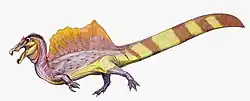Spinosaurus
Spinosaurus was a huge semi-aquatic dinosaur from the Cretaceous, that lived 99 to 93.5 million years ago.[1] It was the largest of all known terrestrial carnivores.[2][3]
| Spinosaurus | |
|---|---|
 | |
| Reconstructed skeleton in swimming posture, National Geographic Museum | |
| Scientific classification | |
| Kingdom: | Animalia |
| Phylum: | Chordata |
| Clade: | Dinosauria |
| Clade: | Saurischia |
| Clade: | Theropoda |
| Family: | †Spinosauridae |
| Tribe: | †Spinosaurini |
| Genus: | †Spinosaurus Stromer, 1915 |
| Type species | |
| †Spinosaurus aegyptiacus Stromer, 1915 | |
| Species | |
| |
| Synonyms | |
| |

It had paddle-like feet and nostrils on top of its crocodile-like head. This would let it submerge, similar to a crocodile.[4][5]
The same research suggests it was larger than Tyrannosaurus rex, but more clumsy on land, moving as a quadruped. All these ideas had been suggested before, but the discovery of a more complete skeleton made palaeontologists think they were correct. The fossil was found in Morocco by a private collector who let scientists examine it.[6]
Spinosaurus bones were first discovered in Egypt in 1912 by German paleontologist Ernst Stromer in 1915. Two species, S. aegyptiacus and S. marocannus, are recognized, but there may only be one. Spinosaurus looked like Baryonyx, except it was larger and more heavily built. Six specimens of Spinosaurus have been uncovered. The first fossils were destroyed in Munich, during World War II, in a 1944 bombing raid by the British.[1]
A note on classification: The material also supports the monophyly of the Spinosaurinae and the separation of Spinosaurus and Irritator.
Description

100 million years ago, the Sahara Desert was wet. Animals included the pterosaur Alanqa, types of giant crocodiles, and theropod predators the size of T. rex. The largest predator was Spinosaurus. In the past, it was thought that Spinosaurus aegyptiacus was bipedal. By 2014, scientists believed that Spinosaurus aegyptiacus was quadrupedal because it is front-heavy. If Spinosaurus aegyptiacus were to walk on two legs, it would topple. Scientists believe that Spinosaurus probably walked on its knuckles. Spinosaurus's legs were short, and its jaws were good at catching slippery prey, like fish. Spinosaurus spent most of its time in the water and it was a semi-aquatic dinosaur.
Spinosaurus was larger than Tyrannosaurus. Estimates published in 2005, 2007, and 2008 suggested that it was between 15 metres (50 ft) in length and 7 to 20.9 tonnes (7.7 to 23.0 short tons) in weight. A new estimate published in 2014 and based on a more complete specimen, supported the earlier research, finding that Spinosaurus could reach lengths of over 15 m (49 ft). It had a two meter high sail on its back like Dimetrodon. Several uses have been suggested for this sail, such as to help control its body temperature, as a way to attract a mate, and to intimidate or frighten enemies. It lived in what is now the Sahara Desert, but which then was mangrove forests alongside shoreline conditions, tidal flats and channels.
The skull of Spinosaurus was long and narrow like that of a modern gharial. Spinosaurus is known to have eaten fish. Evidence suggests that it lived both on land and in water like a modern crocodilian.
Media
It was featured as the main dinosaur in the 2001 film Jurassic Park III where it fights and kills a T-Rex. It has also appeared on postage stamps in several countries, and many toy companies have made models of Spinosaurus.
References
- Morrelle, Rebecca 2014. Spinosaurus fossil: 'Giant swimming dinosaur' unearthed. BBC News Science & Environment.
- Therrien F. & Henderson D.M. 2007. My theropod is bigger than yours...or not: estimating body size from skull length in theropods. Journal of Vertebrate Paleontology. 27 (1): 108–115.
- dal Sasso, C.; Maganuco, S.; Buffetaut, E.; Mendez, M.A. 2005. New information on the skull of the enigmatic theropod Spinosaurus, with remarks on its sizes and affinities. Journal of Vertebrate Paleontology. 25 (4): 888–896.
- Nizar, Ibrahim et al 2014. Semiaquatic adaptations in a giant predatory dinosaur. Science online
- Balter, Michael 2014. Giant dinosaur was a terror of Cretaceous waterways. Science 345 (6202) p1232.
- Chang, Kenneth 2014. A lost-and-found nomad helps solve the mystery of a swimming dinosaur. New York Times.